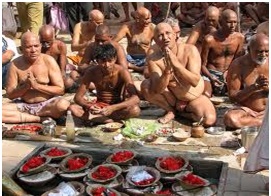Pitrupaksha
In the context of the question when the offerings to the departed ancestors as described
above have to be made, pitru paksha or the fortnight dedicated to the forefathers
assumes significance. The fifteen days of the dark fortnight (krishna paksha)
of the month of Bhadrapada (according to the lunar calendar) or the month
of Ashwin (according to the solar calendar) roughly corresponding to September-October
in the Gregorian calendar are called pitru paksha or mahalaya paksha
and the new-moon day (amavasya) occurring in that period as Mahalaya Amavasya
or Sarvapitru Amavasya. These days are considered to be extremely appropriate
for performing the post-death rites (shraaddh, tarpan, daan etc,) to the
departed forefathers.
The answer to the question why specifically this period has been chosen lies in
the ancient story relating to the Mahabharata hero, Karna. According to tradition,
Karna could not get any food to eat when he went after his death to the higher regions,
though he could get plenty of silver and gold there. This was because he had donated
plenty of gold and silver but not food during his lifetime. Distressed much he prayed
to Lord Yama, the god of death, and through his grace, returned to this earth during
this paksha or the fortnight. He then gifted plenty of food to the hungry
and reached back to his allotted higher plane. Hence annadaana or giving
food to the hungry has become the central part of the rituals during these days.
Yama also ordained that offerings made on these days would benefit all departed
souls whether they were related to the donor or not.
On all the fifteen days, offerings are made to the departed manes, including those
whose names or manner of death are not known. On these days tarpan, shraaddha and
pinda daan are performed daily according to the procedures under the guidance
of a priest. Although these rites are to be carried out daily in this fortnight,
it is considered that to perform them on the last day i.e. on Mahalaya Amavasya
or Sarva Pitru Amavasya is considered extremely important and highly sacred.
Sarvapitri amavasya ("all fathers' new moon day") is intended
for all ancestors, irrespective of the lunar day they died. It is the most important
day of the Pitru Paksha Those who have missed performing shraddha for any
unavoidable reason can do so on this day. A shraddha ritual performed on
this day is considered as fruitful as one conducted in the holy city of Gaya, which
is considered as a special place to perform these rites.
Persons who perform these rites observe certain basic disciplines or austerities
like not having a shave, abstinence from pleasures etc. during this period. As these
days are considered inauspicious for any new ventures, no new purchases or business
commitments are undertaken. Feeding the priests and other invitee brahmanas
with kheer or payasam during this period is considered to be highly
pleasing to the pitrus or the manes.
It is called as Mahalaya because the word ‘Maha’
means great or big or large and ‘Laya’ means destruction.
Mahalaya therefore means great destruction caused during the war between
Deities and Demons wherein large number of Devathas and Rishis had died in the hands
of Rakshasas during the period starting from Bhadrapada Bahula Paadyami to Amavasya.
These Deities and Rishis are like our forefathers and it is befitting to worship
such departed souls during this fortnight that coincides with Mahalaya. Hence, this
fortnight has become very sacred and celestial for performing sacred rites to forefathers.
It is believed that the departed souls will attain peace by the rituals and rites
performed during Pitru Paksha and they will, in turn, give their blessings
to the descendents who performed these ceremonies for their welfare and prosperity
of their Vamsam or lineage. It is said that departed souls for whom these rituals
are not performed wander aimlessly on the Earth. It is believed that performance
of these rites to forefathers will work as a remedy for various mundane problems
one may face day to day.
FINALE
Finally, shorn of all the rituals and myths, this is a fortnight of remembrances
and thanks giving. It reminds all of us to be grateful to our forefathers on this
day and to pray for them who have left this world. Even if our rational mind, soaked
in scientific ideas, may not justify the rationale behind these ceremonies, it might
still be a good idea to just remember our forefathers and silently pay our obeisance
to them.
In this connection the words of Maha Mahopadyaya Dr.P.V.Kane in his work “History
of Dharma Shastra” Vol. IV (Bhandarkar Oriental Research Institute,
Pune) can be profitably recalled.
“It is a good practice to set apart at least one day in a year for the remembrance
of one’s near and dear relatives, friends and learned people that are no more,
to invite relatives, friends and learned people to a dinner in memory of the dead
and to bestow monetary gifts on poor but learned persons of character and devoted
to the practice of plain living and high thinking. This will be in keeping with
our past traditions and will also give a new orientation to and infuse new life
into practices that have become lifeless and meaningless to many people”.
(Quoted in the “The Concise Encyclopaedia of Hinduism” Vol.3 published
by Ramakrishna Math, Bangalore).

Also read
1.
Samskaras Origin and significance
2. Naming ceremony
3. Cremation ceremony